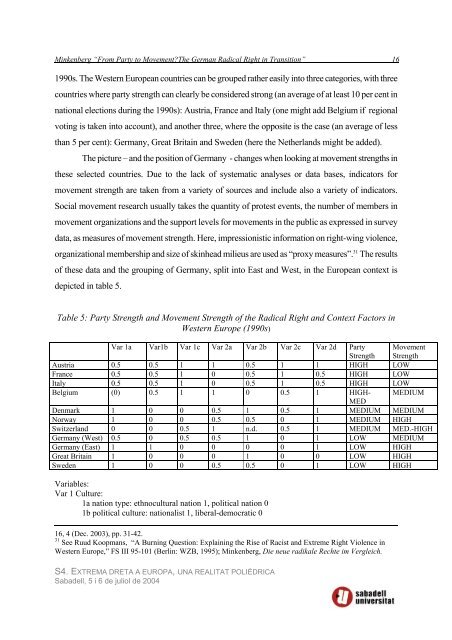From Party to Movement? The German Radical Right
From Party to Movement? The German Radical Right
From Party to Movement? The German Radical Right
You also want an ePaper? Increase the reach of your titles
YUMPU automatically turns print PDFs into web optimized ePapers that Google loves.
Minkenberg “<strong>From</strong> <strong>Party</strong> <strong>to</strong> <strong>Movement</strong>?<strong>The</strong> <strong>German</strong> <strong>Radical</strong> <strong>Right</strong> in Transition” 16<br />
1990s. <strong>The</strong> Western European countries can be grouped rather easily in<strong>to</strong> three categories, with three<br />
countries where party strength can clearly be considered strong (an average of at least 10 per cent in<br />
national elections during the 1990s): Austria, France and Italy (one might add Belgium if regional<br />
voting is taken in<strong>to</strong> account), and another three, where the opposite is the case (an average of less<br />
than 5 per cent): <strong>German</strong>y, Great Britain and Sweden (here the Netherlands might be added).<br />
<strong>The</strong> picture – and the position of <strong>German</strong>y - changes when looking at movement strengths in<br />
these selected countries. Due <strong>to</strong> the lack of systematic analyses or data bases, indica<strong>to</strong>rs for<br />
movement strength are taken from a variety of sources and include also a variety of indica<strong>to</strong>rs.<br />
Social movement research usually takes the quantity of protest events, the number of members in<br />
movement organizations and the support levels for movements in the public as expressed in survey<br />
data, as measures of movement strength. Here, impressionistic information on right-wing violence,<br />
organizational membership and size of skinhead milieus are used as “proxy measures”. 31 <strong>The</strong> results<br />
of these data and the grouping of <strong>German</strong>y, split in<strong>to</strong> East and West, in the European context is<br />
depicted in table 5.<br />
Table 5: <strong>Party</strong> Strength and <strong>Movement</strong> Strength of the <strong>Radical</strong> <strong>Right</strong> and Context Fac<strong>to</strong>rs in<br />
Western Europe (1990s)<br />
Var 1a Var1b Var 1c Var 2a Var 2b Var 2c Var 2d <strong>Party</strong> <strong>Movement</strong><br />
Strength Strength<br />
Austria 0.5 0.5 1 1 0.5 1 1 HIGH LOW<br />
France 0.5 0.5 1 0 0.5 1 0.5 HIGH LOW<br />
Italy 0.5 0.5 1 0 0.5 1 0.5 HIGH LOW<br />
Belgium (0) 0.5 1 1 0 0.5 1 HIGH- MEDIUM<br />
Denmark 1 0 0 0.5 1 0.5 1 MEDIUM MEDIUM<br />
Norway 1 0 0 0.5 0.5 0 1 MEDIUM HIGH<br />
Switzerland 0 0 0.5 1 n.d. 0.5 1 MEDIUM MED.-HIGH<br />
<strong>German</strong>y (West) 0.5 0 0.5 0.5 1 0 1 LOW MEDIUM<br />
<strong>German</strong>y (East) 1 1 0 0 0 0 1 LOW HIGH<br />
Great Britain 1 0 0 0 1 0 0 LOW HIGH<br />
Sweden 1 0 0 0.5 0.5 0 1 LOW HIGH<br />
Variables:<br />
Var 1 Culture:<br />
1a nation type: ethnocultural nation 1, political nation 0<br />
1b political culture: nationalist 1, liberal-democratic 0<br />
S4. EXTREMA DRETA A EUROPA, UNA REALITAT POLIÈDRICA<br />
Sabadell, 5 i 6 de juliol de 2004<br />
MED<br />
16, 4 (Dec. 2003), pp. 31-42.<br />
31 See Ruud Koopmans, “A Burning Question: Explaining the Rise of Racist and Extreme <strong>Right</strong> Violence in<br />
Western Europe,” FS III 95-101 (Berlin: WZB, 1995); Minkenberg, Die neue radikale Rechte im Vergleich.













